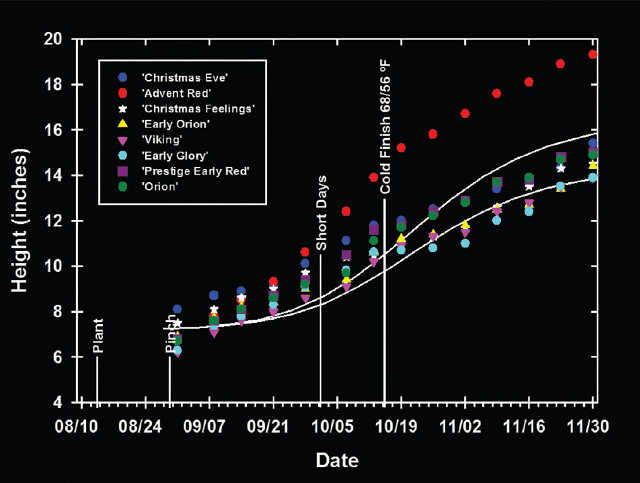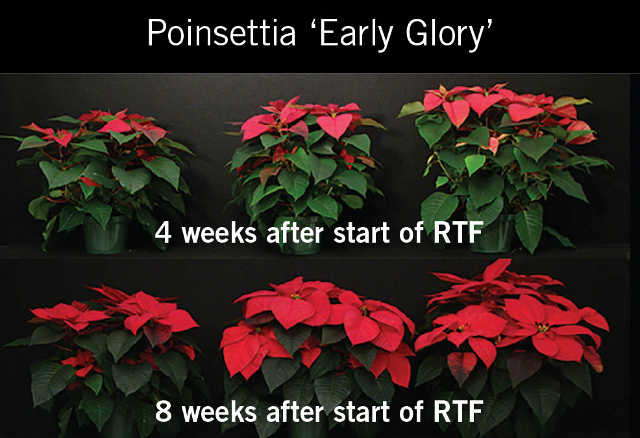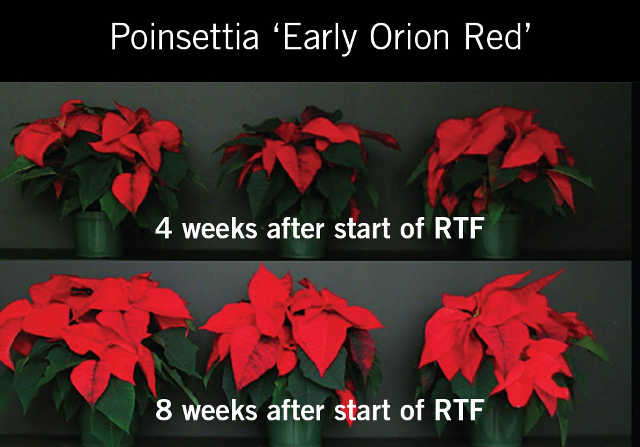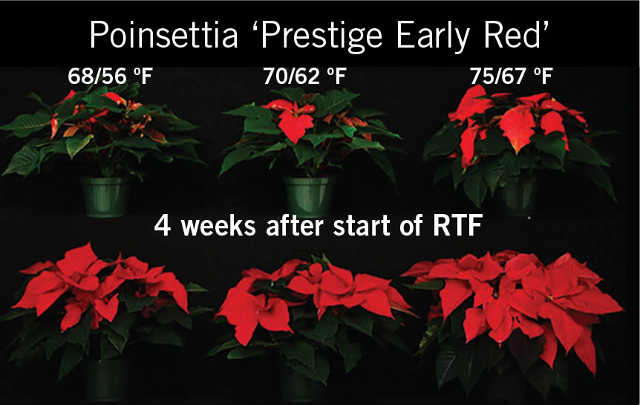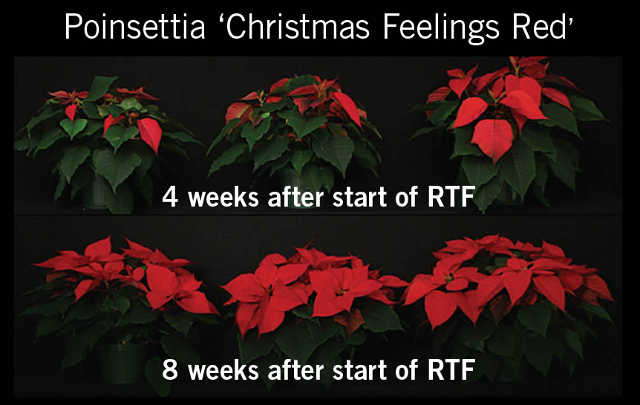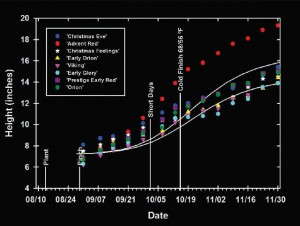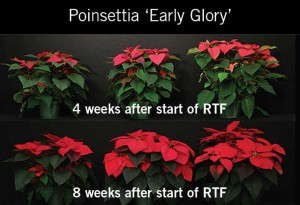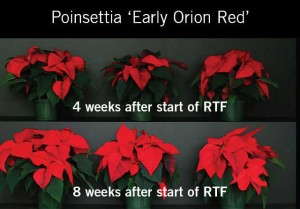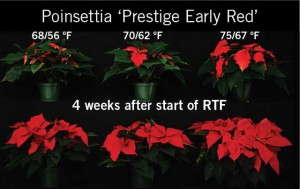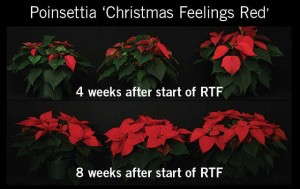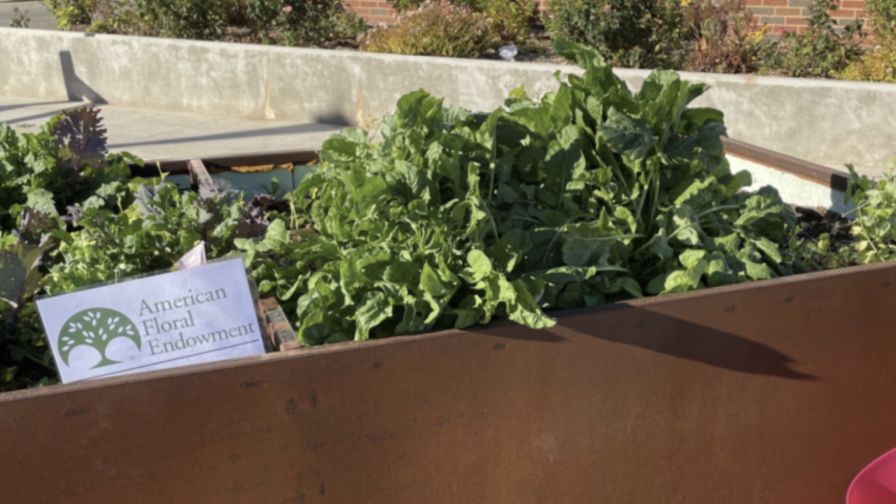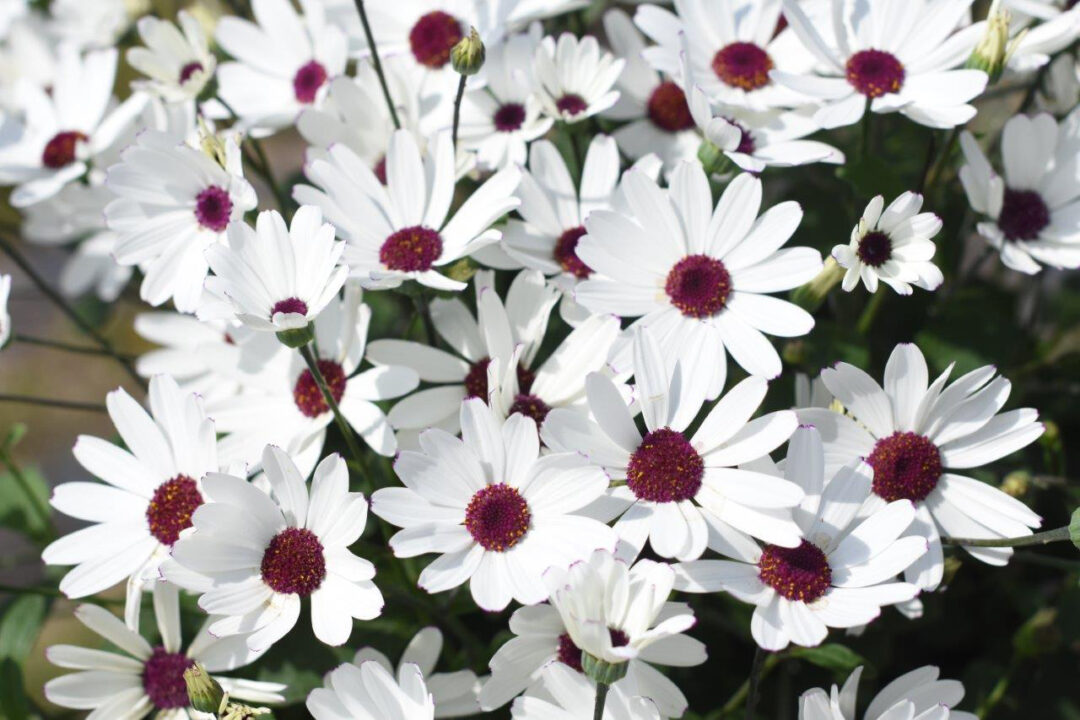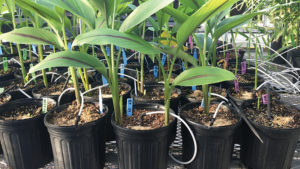Basics & Beyond: Cold Finishing Poinsettias
It’s not too early to start thinking about your 2014 poinsettia crop, especially when it comes to saving on fuel as energy costs for heating are on the rise. Over the last several years, we have been fortunate that the price for natural gas has been much lower than the all-time high set back in 2008. However, natural gas prices are once again on the rise, according to the U.S. Energy Administration (www.eia.gov). Unfortunately, those of you using propane and heating oil have seen prices steadily increase in the past decade with little or no relief in sight.
One strategy to reduce your heating bill during poinsettia production is to reduce temperatures during finishing (RTF). This is often referred to as cool- or cold-finishing. Poinsettia RTF is a viable option that growers can use to help reduce both energy and input costs; however, it is important to remember that not all cultivars can be finished under RTF successfully. For example, when certain poinsettia cultivars are placed under RTF, their finish height and bract size is unacceptable, and their time to finish is significantly delayed compared to those finished at warmer temperatures.
Because red poinsettias account for more than 80 percent of today’s poinsettia sales, Dümmen, Ecke, Selecta and Syngenta each submitted two of their red cultivars to RTF research at Purdue University and the University of New Hampshire based on their early response attributes (initiate and finish within six to eight weeks), moderate to high-vigor and naturally large bracts. These attributes are essential for successful RTF. The objectives of our studies were to quantify how RTF applied two weeks after the start of short days (SD) influenced plant height, bract area index and time to marketability and anthesis (first pollen shed).
[blackoutgallery id=”55851″]Research Procedures
Rooted cuttings of ‘Advent Red,’ ‘Christmas Eve Red,’ ‘Christmas Feelings Red,’ ‘Early Glory,’ ‘Early Orion Red,’ ‘Prestige Early Red,’ ‘Orion Red’ and ‘Viking Red’ were received at Purdue University in West Lafayette, Ind. (lat. 40°N) and the University of New Hampshire in Durham, N.H. (lat. 43°N) on week 31, 32 or 33 and transplanted into 61/2-inch containers. They were grown at day/night temperatures (12 h/12 h) of 75°F/67°F, for an average daily temperature (ADT) of 71°F. Day extension lighting was provided by high pressure sodium lamps (HPS), until the start of short days on October1. Black cloth was used to provide short days only at Purdue.
On October 15, plants of each cultivar and from each planting date were transferred to greenhouse compartments for RTF with constant temperature set points of 62°F or 66°F or day/night temperature set points of (12h/12h) 61°F/55°F, 68°F/56°F, 70°F/62°F or 75°F/67°F, for a total of six different RTF temperatures.
Research Results
At both locations, quality parameters (height, bract area index and bract area to height ratio which is a measure of how proportional bract area and plant height are to each other) were reduced when plants were placed under RTF of constant 62°F and 66°F or when the day/night temperature set point (12 h/12 h) was 61°F/55°F.
Bract area index of plants transplanted on week 33 and placed under RTF of 66°F, 62°F and 61°F/55°F was reduced by 34, 52 and 88 in two, respectively, when compared to plants finished at 75°F/67°F. Time to anthesis (TTA), or the amount of time before plants flowered, significantly increased across cultivars when finished at 61°F/55°F. For example, average TTA of ‘Prestige Early Red,’ ‘Viking Red’ and ‘Early Glory’ occurred after December 15.
Height. Figure 1 displays the average weekly height (graphical tracking) of each of the eight cultivars planted on week 33 and placed in RTF on October 15 (week 42) at 68°F/56°F. Until the start of RTF (cool or cold finish), the height of all the cultivars was above the graphical tracking curve because we did not use plant growth regulators (PGRs). Allowing the plants to grow above the curve prior to RTF compensated for the reduced stem elongation that occurred during RTF. In Figure 1, we can also see that the final heights of seven of the eight moderate to high vigor cultivars planted on week 33 in our study were within or near the 14- to 16-inch range. As would be expected, final height of all the poinsettia cultivars planted on weeks 31 or 32 was significantly greater than those planted on week 33 and would more than likely require a PGR application.
Timing. One of the most important factors that can limit RTF is the delay in timing that can occur from reduced finish temperatures. In our study, TTA increased by two to 15 days and 15 to 22 days, as the finishing temperature was reduced during the day/night by 5°/5° (70°F/62°F) and 7°/11° (68°F/56°F) respectively, beginning on October 15, compared to the 75°F/67°F treatment. Therefore, early season cultivars with a six- to eight-week response time should finish and be marketable between mid- to late-November if they are started on week 31 or 32. It is also important to note that plants can be marketable from a few days to two weeks before anthesis, depending on the cultivar.
Impacts To The Industry
Although reducing heating costs is the primary draw to RTF, there are other added benefits to this production scheme, including reduced or no PGR usage, an increased postharvest life of the plants and intense and brighter bract colors. This can translate into higher consumer satisfaction.
All of the red cultivars that we tested in our three years of trialing were successfully cold finished at 68°F/56°F and 70°F/62°F without excessive delays in timing or negative effects on height or bract area. Keep in mind that the base temperature, or the temperature at which the rate of development is zero, is 50°F for poinsettia. Therefore, night temperatures should never drop below 55°F to obtain a desired average daily temperature. Likewise, excessively high temperatures during the day can cause heat delay.
The practice of poinsettia RTF has shown promise as a cost savings technique in this study. Contact your poinsettia supplier to determine which cultivars are suitable for RTF. We strongly encourage growers who are interested in RTF to conduct onsite trials of their own with different cultivars to determine how their specific growing conditions influence timing and other plant quality parameters. These studies were conducted under low light northern U.S. conditions; therefore growers in the south may need to apply PGRs conservatively.
Editor’s Note: The author thanks The Fred C. Gloeckner Foundation and The American Floral Endowment for funding. Dümmen, Paul Ecke Ranch, Selecta and Syngenta Flowers, Inc., for plants and financial support. Fafard, Everris and L.S. Svensson for donating growing substrate, fertilizer and black cloth, respectively.




